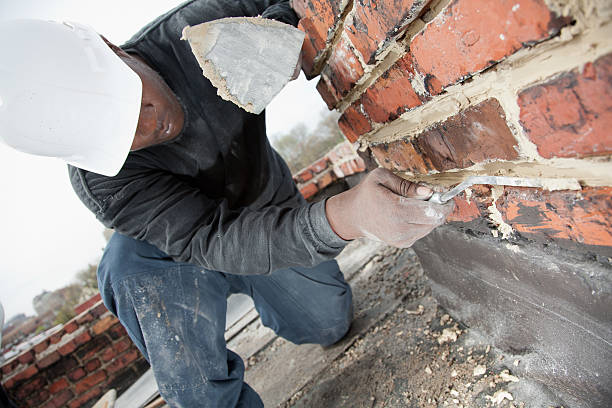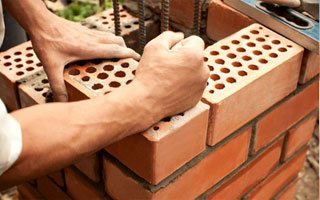Unlocking the Tricks of Lasting Stonework Building Practices for Eco-Friendly Buildings
In the realm of modern-day building, the pursuit of lasting methods has come to be extremely important. Amongst the myriad strategies to environmentally friendly structure, lasting stonework building and construction stands out as a tried and true and durable technique that holds a wide range of untapped potential. From the choice of materials to ingenious building strategies, the keys to accomplishing sustainability within masonry building and construction are multifaceted and appealing. By exploring the benefits, products, methods, and future trends of lasting masonry, a deeper understanding of just how these practices can form the future of environmentally friendly structures emerges.
Advantages of Sustainable Masonry Construction
Embracing lasting masonry construction methods not only reduces ecological impact yet likewise provides long-term financial advantages to contractors and communities. By using products like recycled blocks, obstructs, and rocks, building contractors can dramatically decrease the carbon footprint of their projects while promoting source efficiency. Furthermore, sustainable stonework building and construction techniques, such as correct insulation and thermal mass properties, can enhance energy effectiveness within buildings, resulting in minimized functional expenses over time.
In addition, the resilience and resilience of masonry frameworks contribute to long-term financial advantages. Buildings built utilizing sustainable masonry techniques often call for less maintenance and repair service, equating to cost savings for contractors and homeowner. The longevity of stonework materials likewise makes certain that structures stay secure and protected, lowering the need for frequent improvements or substitutes.
Eco-Friendly Masonry Materials
Utilizing environment-friendly masonry materials is an essential action towards improving the sustainability of construction practices and decreasing environmental effect while taking full advantage of long-term economic advantages. Sustainable masonry materials are sourced, created, and utilized in a manner that minimizes overall ecological effect. Lasting concrete blocks include recycled accumulations and might include better insulation residential properties, adding to energy effectiveness in buildings.
Additionally, natural products like adobe, rammed planet, and straw bales provide outstanding thermal mass residential properties, lowering the need for home heating and cooling down power. These products are often locally readily available, advertising regional economies and decreasing transportation-related carbon discharges. By choosing eco-friendly stonework products, building jobs can dramatically reduce their ecological footprint and add to the creation of healthier, much more sustainable developed atmospheres.
Energy-Efficient Masonry Methods
Energy effectiveness plays a crucial function in enhancing the sustainability of masonry construction practices. By executing energy-efficient masonry methods, building contractors can significantly decrease the general energy consumption of a building, resulting in lower operational expenses and a smaller sized ecological impact. One crucial energy-efficient stonework method is the use of thermal mass, which includes integrating thick materials like concrete or block into the building's framework to absorb and save warm. This aids regulate indoor temperature levels, lowering the demand for mechanical heating and cooling systems.

Developments in Lasting Stonework
Current improvements in sustainable masonry practices have brought about innovative techniques that are reshaping the construction industry. One such development is the development of self-healing concrete, which makes use of microorganisms installed within the concrete to recover cracks autonomously. This breakthrough not just lowers upkeep prices yet likewise enhances the sturdiness of masonry structures, adding to their sustainability.
An additional remarkable innovation is the advice usage of recycled aggregates in stonework building - masonry contractor. By including materials read here such as smashed ceramic waste or recycled glass into concrete blends, contractors can lower the environmental influence of building projects while keeping structural stability. This method not just draws away waste from landfills but likewise conserves natural deposits, making it an essential advancement in lasting stonework building
In addition, the integration of electronic design tools, such as Structure Info Modeling (BIM), is changing the method stonework frameworks are prepared and created. BIM permits for more precise computations, reduced material wastefulness, and enhanced energy effectiveness, ultimately causing even more sustainable structure techniques. These developments collectively symbolize a promising future for sustainable stonework building in the age of eco-friendly buildings.
Future Trends in Stonework Sustainability
With the innovative strides made in sustainable masonry techniques, the future patterns in stonework sustainability are poised to additional change the building market. One of the essential trends shaping the future of masonry sustainability is the increased integration of technology. Developments such as Building Details Modeling (BIM) and virtual fact simulations are being made use of to maximize stonework building procedures, bring about lowered product waste and boosted power performance in buildings.
Moreover, the advancement of unique lasting products is readied to play a considerable function in enhancing the eco-friendliness of stonework building. masonry contractor. Advancements like self-healing concrete, recycled aggregates, and bio-based binders are getting grip for their ability to reduce environmental impact while maintaining structural stability

Verdict
In final thought, lasting stonework building and construction practices offer countless advantages for eco-friendly structures. By using eco-friendly products and energy-efficient methods, stonework can add to an extra lasting developed setting. Advancements in lasting stonework are continually being developed to further boost the environmental efficiency of structures. Looking towards the future, the pattern of stonework sustainability is anticipated to grow, resulting in even more eco-friendly and energy-efficient building practices in the years ahead.